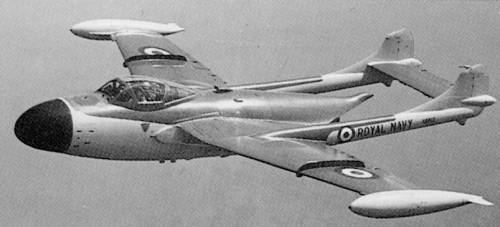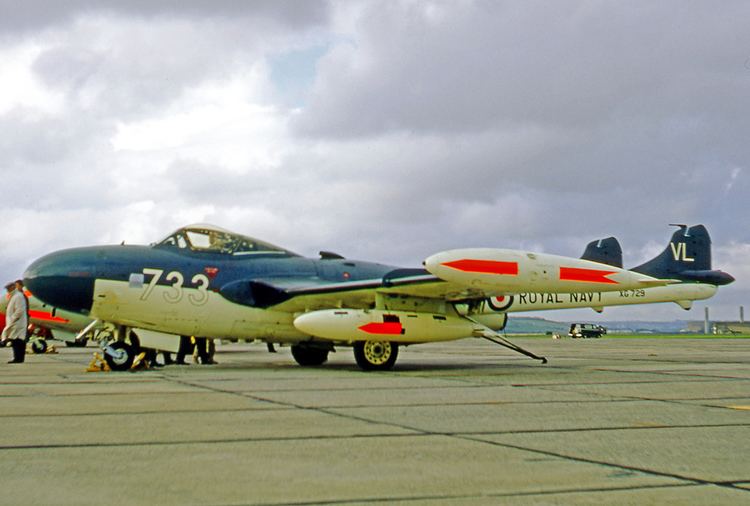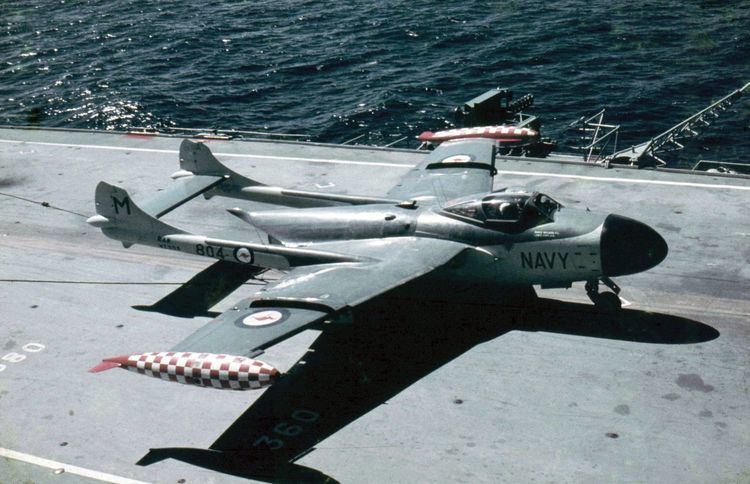Top speed 925 km/h Length 11 m | Wingspan 13 m | |
 | ||
The de Havilland Sea Venom was a British postwar carrier-capable jet aircraft developed from the de Havilland Venom. It served with the Royal Navy Fleet Air Arm and with the Royal Australian Navy. The French Navy operated the Aquilon, a version of the Sea Venom FAW.20 licence-built by SNCASE (Sud-Est).
Contents
- Classic jets fighter museum de havilland sea venom
- Design and development
- Royal Navy service
- Service with other nations
- Sea Venom
- SNCASE Aquilon
- Sea Venom operators
- Aquilon operators
- Surviving aircraft
- Specifications Sea Venom FAW22
- References

Classic jets fighter museum de havilland sea venom
Design and development

The Sea Venom was the navalised version of the Venom NF.2 two-seat night fighter, and was used as an all-weather interceptor by the Fleet Air Arm (FAA). The necessary modifications for use on the Royal Navy's aircraft carriers included folding wings, a tailhook (which retracted into a characteristic "lip" over the jetpipe) and strengthened, long-stroke undercarriage. The canopy was modified to allow ejection from underwater. The first prototype made its first flight in 1951, and began carrier trials that same year. A further two prototypes were built. The first production Sea Venom took the designation FAW.20 (Fighter, All-Weather). It was powered by a single de Havilland Ghost 103 turbojet engine and its armament was the same as the RAF version. The next variant was the FAW.21, which included the modifications introduced in the Venom NF.2A and NF.3. Some of these modifications included the Ghost 104 engine, a clear-view canopy and American radar. The final Royal Navy variant was the FAW.22 powered by the Ghost 105 engine. A total of 39 of this type were built in 1957–58. Some were later fitted out with the de Havilland Firestreak air-to-air missile.

Seven FAW.21s were modified in 1958 for Electronic countermeasures (ECM) purposes, with the cannon replaced by the ECM equipment. These became the ECM.21. 831 Naval Air Squadron, the sole squadron to be equipped with it, was shore-based at RAF Watton from 1963 and disbanded in 1966. Converted FAW.22s were similarly known as the ECM.22.

A modernised Sea Venom project, the DH.116 with swept wings and upgraded radar was considered, but cancelled as the Royal Navy believed that any replacement needed two engines. The de Havilland Sea Vixen ultimately replaced the Sea Venom.
Royal Navy service

In 1956 Sea Venoms, alongside RAF Venoms, took part in the Suez War which began on 31 October. They were from Nos. 809, 891, 893, 894, 895 Naval Air Squadrons based on the light fleet carrier HMS Albion and fleet carrier HMS Eagle. The Anglo-French invasion, codenamed Operation Musketeer, took place in response to the nationalisation of the Suez Canal by Egypt's leader, General Nasser. The air war began on the 31 October 1956 signalling the beginning of the Suez War. The Sea Venoms launched many sorties, bombing a variety of targets in Egypt in the process.
Sea Venoms also saw service during conflicts in the Middle East.
By 1959, the Sea Venom began to be replaced in Royal Navy service by the de Havilland Sea Vixen, an aircraft that also had the distinctive twin-boom tail. The Sea Venom would be withdrawn from frontline service soon afterwards. The type continued to fly with second line FAA units until the last were withdrawn in 1970.
Service with other nations
Thirty-nine Sea Venom FAW.53s saw service with the Royal Australian Navy (RAN), replacing the Hawker Sea Fury. The Sea Venom entered service in 1956 and, during its service with the RAN, operated off the aircraft carrier HMAS Melbourne. It was taken out of first-line service in 1967, replaced by the American McDonnell Douglas A-4G Skyhawk. The Aquilon saw service with the French Navy until being withdrawn in 1963.
Sea Venom
SNCASE Aquilon
SNCASE (Sud-Est) licence-built 121 Sea Venom FAW.20 as the Aquilon for the French Navy.
Sea Venom operators
Aquilon operators
Surviving aircraft
Specifications (Sea Venom FAW.22)
Data from De Havilland's Sea Vixen
General characteristics
Performance
Armament
